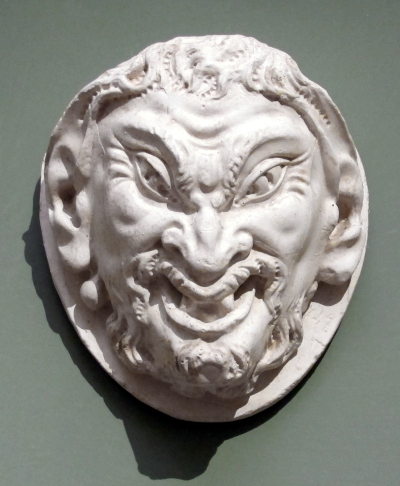Introduction
It is unfortunate that many of Michelangelo's early creations were not afforded the care and respect that they would receive today. Despite showing artistic promise from a young age, there were no guarantees that Michelangelo would succeed as an artist, certainly not to the level that he would later achieve. As such, many items that he produced whilst working as an apprentice or early professional were passed around studios and between donors with little understanding of their future value.
Michelangelo's Head of a Faun is a good example of that. It is believed to have been the sculpture which opened the Medici doors to Michelangelo, convincing the influential family of the potential held by this young Florentine artist. Yet despite the sculpture's role in his progression, it would be lost, presumed destroyed in later years. All we have left is a possible cast of it, once displayed in the Bargello Museum.
The sculptor's Head of a Faun is dated to around circa 1489, which would make Michelangelo around fourteen years of age (possibly older) at the time that he put this artwork together. We would therefore have been able to learn much from it, had it not been lost. The most information that we have on it is derived from Giorgio Vasari, who was one of the most prominent Renaissance biographers and who actually spent time in the company of many of these great masters.
Table of Contents
- Introduction
- What is a Faun?
- Description
- Reaction from Lorenzo il Magnifico
- Attribution of a Related Mask
- Famous Faun Sculptures and Paintings
What is a Faun?
Fauns are mythological creatures with roots in Greek and Roman classical literature. Coming from the Latin word, Faunus, they are half-human and half-goat. These unusual beasts have proven popular in western art, and are often depicted in a playful, child-like manner. Whilst they were most commonly used within classical Roman and Greek art, as well as the Italian Renaissance, they re-appeared once more during the 19th century.
Description
Judging by the cast which might be accurate to the original sculpture, Head of a Faun featured a round base on which the head is placed centrally. Its face is contorted, with a happy but somewhat sinister smile, with a wide nose and an uneven display of teeth. Long ears and unusually angled eyes continue to build the appearance of this mytholigical creature, and potentially the young Michelangelo might have enjoyed creating the appearance of this monstrous beast.
The beard and attached moustache swirl down his face, with wrinkles appearing around his eyes. The depiction differs from many other Renaissance Fauns, with this version appearing middle aged, and certainly without the same child-like innocence that other artists chose to incorporate into their works.
Inspiration
The piece is believed to have actually been a copy by Michelangelo of an ancient work, suggesting that all of these stylistic choices were not made by him at all. He is known to have copied elements of classical sculpture early in his career as a means to learning technique, and so this explanation could easily be true. The item may even have been a mask, to be worn on special occasions, in order to shock fellow guests.
Michelangelo's Alterations to the Ancient Piece
Some evidence has suggested that Michelangelo actually adapted the classical version with his own ideas, and that specfically the nose and laughing mouth were entirely his own idea. With neither his version, nor the ancient original now available, it is hard to confirm this but we could take an educated guess by exmaining some of his other works from whilst a teenager.
Reaction from Lorenzo il Magnifico
Michelangelo's Head of a Faun was presented to Lorenzo il Magnifico shortly after the young Michelangelo had completed it. The Medici praised the sculptor for what he had achieved at such a young age, though did criticise some elements of its design, purely in order to help the young artist. His comments were taken in the same spirit as they were given, and clearly Michelangelo was a more open minded, humble character in his early years, as compared to later on when his reputation had soared.
Attribution of a Related Mask
For many centuries another mask existed which was believed to be the lost sculpture that we discuss here. It was only as recently as 1860 that its attribution was questioned and eventually removed from the name of Michelangelo. It passed through multiple Italian collections before being stolen during WWII. Its disappearance makes it impossible to discuss how accurate it might have been to Michelangelo's original piece.
Famous Faun Sculptures and Paintings
Greek and Roman mythology has inspired western artists for many centuries, and the Faun creature is one of the themes which has re-appeared many times over. It has also been taken into a great variety of different artistic movements, ensuring different approaches to the same content. Michelangelo himself would have been inspired by previous artists' attempts at depicting Fauns, but mostly was working directly from the original sculpture that dated to ancient Greek and Roman times. From all of the related faun paintings and sculptures, from a variety of famous artists and artistic periods, to be found elsewhere in this site, you may be particularly interested in A Faun Teased by Children and Barberini Fawn by Gian Lorenzo Bernini.
Image Credit
The image of the Head of a Faun included within this page was contributed to Wikimedia by Sailko under the CC BY-SA 3.0 license. More details on this image, including a link to its original form can be found below. Their contribution is much appreciated and we encourage you to check out more of their contributions, via their wikimedia profile.
Head of a Faun, 1489 by Michelangelo, "Calco della testa di satiro"; Sailko, CC BY-SA 3.0, via Wikimedia Commons
Bibliography
- Images sourced from Wikimedia under a variety of Creative Commons licenses. Further details regarding the particular license used, the location of the original image on Wikimedia and the original author/user are provided on each specific page.
- Michelangelo, Gilles Néret
- Vasari's Lives of the Artists, Giorgio Vasari
- Michelangelo. The Complete Works. Paintings, Sculptures, Architecture, Frank Zöllner, Christof Thoenes
- Michelangelo and the Sistine Chapel, Andrew Graham-Dixon





